Sound making – Sound walking
Part 1 | 9.11.2023
Chosen object: Projector
Chosen Room: HIL G65
A projector is found in every studio space or lecture hall. Pressing on the button to start the machine triggers the fan to rotate which creates a whirring sound that gradually fades. The clicking sound of the button is manually controlled, creating this dichotomy of the human and the machine. After a while, the fan whirring sound becomes more balanced and stabilized, segueing into a low frequency wave. When shutting down the machine, the fans slow down almost instantaneously, creating a drastic change in the air movement and this is recorded in the dramatic dampening of sound. We adjusted the sensitivity knobs several times to achieve an equal and more balanced signal on both tracks and adjusted the distance of the microphone to the projector for a clearer signal.
Part 2 | 16.11.2023
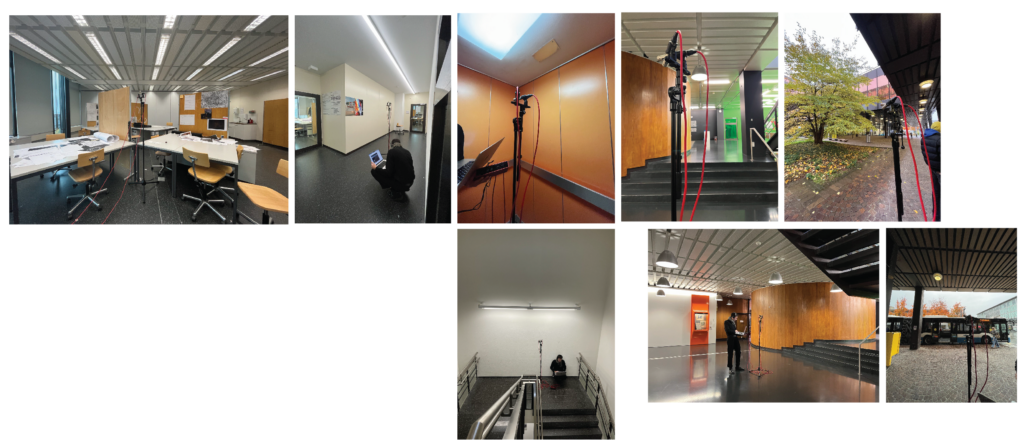
Spatial Sequence [1] Bus stop [2] Courtyard space [3] Main stairwell next to Alumni Lounge Cafe [4] Elevator [5] Stairwell [6] Enclosed corridor vacuum [7] Studio
The soundwalk begins on a Thursday afternoon with one alighting from the bus at the ETH Hönggerberg campus. The loud, mechanical sounds reverberate in the open road where heavy vehicles and bouts of people move through the outdoor public space. Progressing deeper into the building’s foyer, one then becomes gradually attuned to the light patter of rain and leaves rustling in the wind where nature sounds gradually dominate, providing a moment of pause and reflection in an outdoor courtyard environment. Moving indoors to HIL, the stairwell on the ground floor facilitates a rich variety and rhythms of transient sounds of footsteps, music and chatter leaking from the café.
One then goes to the stairwell where footsteps, sound of doors opening to enter the studios and toilets reverberate in the large extended vertical spatial volume, creating echoey and muffled sound qualities. One may also choose to take the elevator where the clarity of sound becomes comparably more pronounced in the tight spatial volume where mechanical whirring sounds of the lift machinery can also be heard.
The corridor serves as a transit point where the slightest sound is amplified in the vacuum space enclosed by three doors. The aggressive opening and closing of doors with people’s typically rapid movement through the space is amplified.
One finally enters the studio leading to where our chosen object resides. It is partially filled with students compared to a normal studio day. Panels are arranged diagonally in a zig-zag panel across the entire space, causing interesting reflections and reverberations of sound. The microphone was placed in the centre of the studio space to record the different intensities of voices, chairs moving, and sounds of lower frequencies such as the rapid typing on the keypad, paper shuffling etc.
The rhythms of people moving through the spaces draw parallels to the critical duration for comparative listening between the different acoustic situations indoors and outdoors. Where the shuffling footsteps are louder and faster, the duration to appreciate this shift also takes on a faster rhythm compared to a contrasting scenario of slower, more melodic sounds of nature in the outdoor courtyard.

The full picture
Our studio is a place where we spend time every day. That’s what makes it interesting for us. We are dependent on it, so to speak, and its acoustics play a crucial role in this context. We think that the acoustic qualities of the room have just as important an influence on our well-being, our productivity and ability to concentrate as, for example, the air quality or the visual connection to the outside.
The main purpose of the studio space is working, lectures, presentations and desk crits. But in our design studio also movie screenings play an important role that’s why it is also used as a “temporary cinema”.
During studio days, ambient sounds usually fade in the background but on non-studio days or in the evening the studio is so quiet that you can also hear the sounds from the neighbouring studios. The studio itself but also the anteroom are like a vacuum, which is why you can often hear the draught and the door that constantly opens and closes as soon as someone enters the anteroom.
Studio in a quiet state (Early mornings, during lunch break and in the night)
Room Configurations for multipurpose use

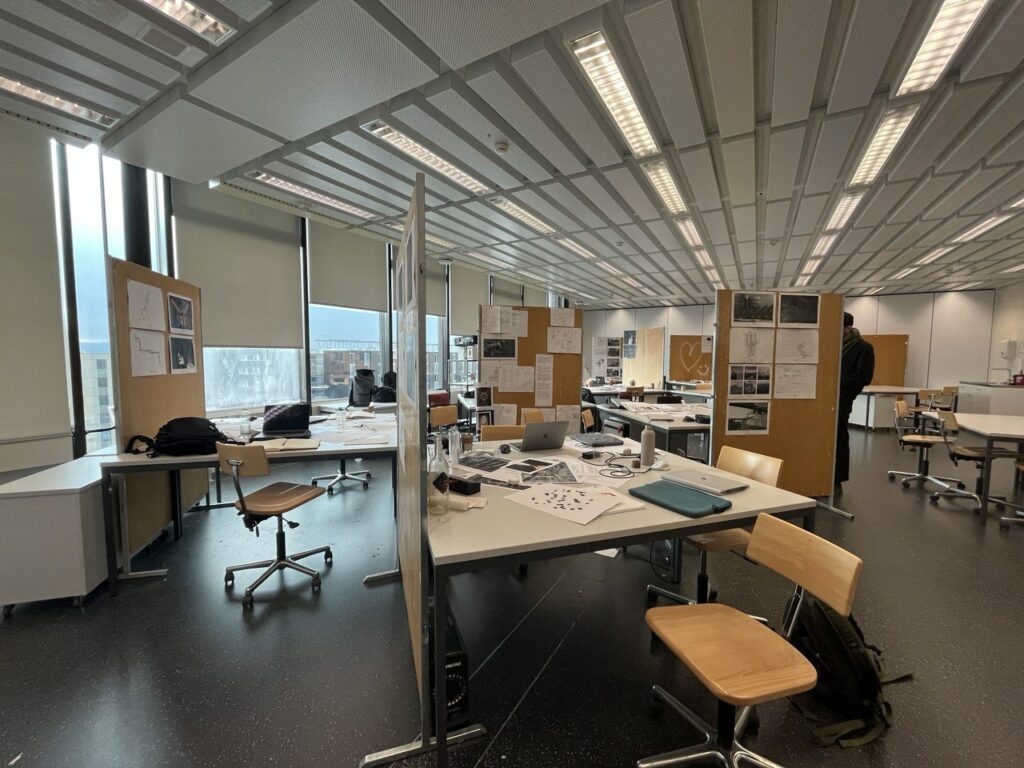
The rectangular space has a few qualities that make it acoustically noteworthy. We noticed that in this standardized room the configuration and adaption of furniture and movable walls strongly affect the acoustic qualities of the room.

Room Configuration 1:
When the semester began, 5 tables each were set up in rows, forming a total of 4 islands around which the students sat. We noticed that there was a constant noise in the studio as soon as people started talking. The noise of only a few people therefore affected everyone else quite significantly.

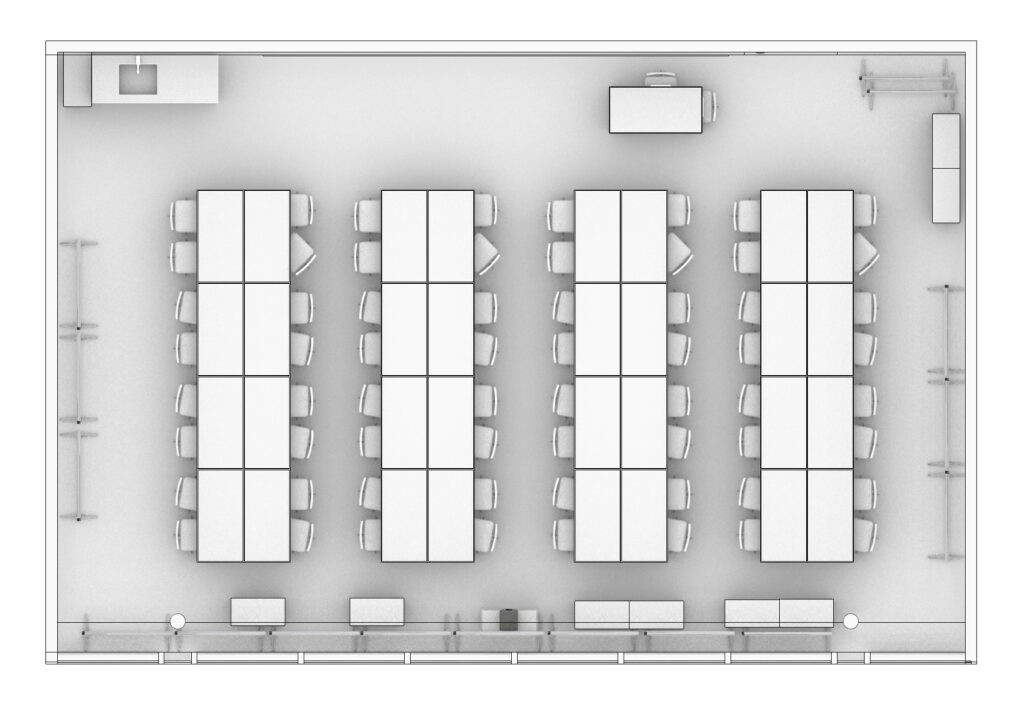
Room Configuration 2:
Later we changed the layout and created 9 little islands out 2 tables each where groups of 2-3 students could work. Next to each work space we installed the movable walls that we use for presenting and collecting our drawings and thoughts. The idea was also to form more acoustically private spaces by this division, so that the movable walls are not only visible barriers but also changing the room acoustics.

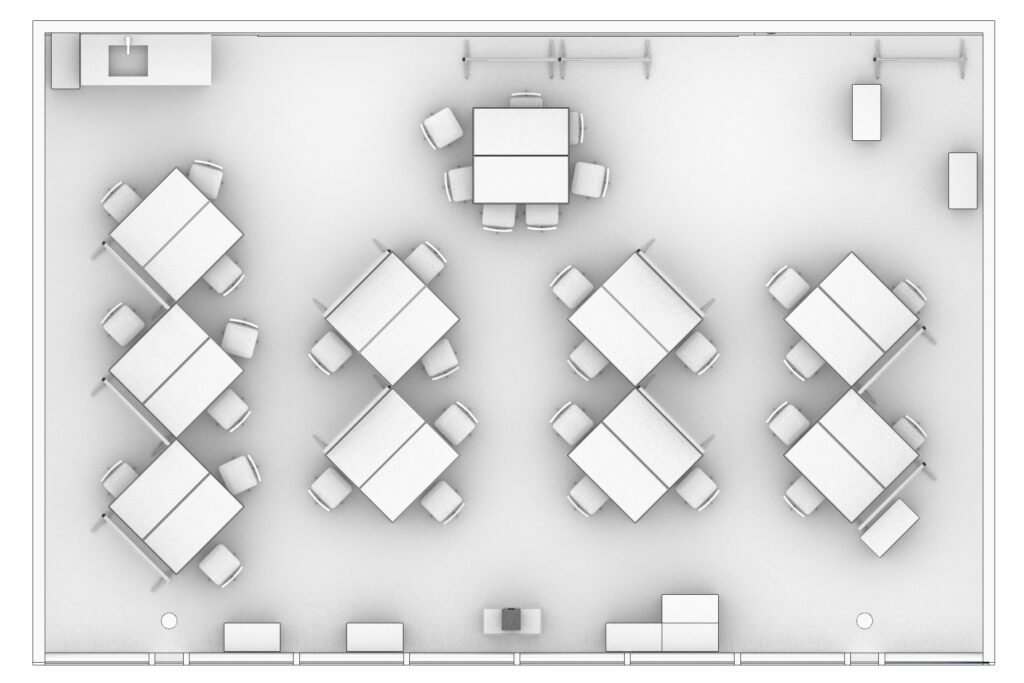
Room Configuration 3: Future Improvements
Movie Screenings:
- improving material properties to absorb a greater range of sound frequencies and using furniture to reconfigure the directions sound travel
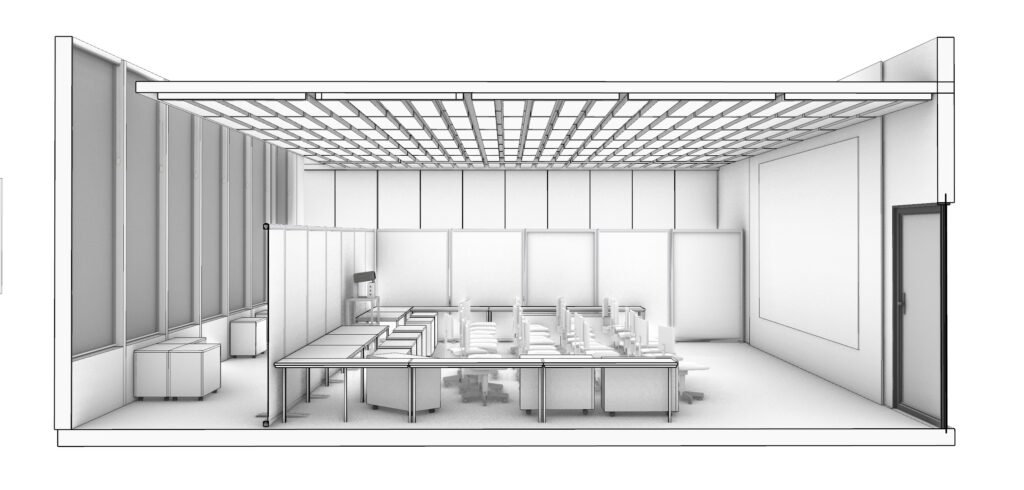

Lectures/ Presentations:
- reconfiguring the space so sound radiates from a central source similar to the idea of the amphitheatre


Reverberation time requirements (DIN18041):
Since our studio is mainly about communication and exchange, either between individuals, between groups or in the sense of more frontal teaching with a speaking person, special attention should be paid to categeories A2 to A4.
In the A2 category, it is stated that this applies specifically to individual speakers, while the focus is less on several groups of people speaking in the room at the same time. Therefore, one of the other categories probably applies better to our case.
As category A4 refers in particular to users with hearing impairments, we think category A3 applies best to our studio. (Kommunikationsintensive Nutzungen mit mehreren gleichzeitigen Sprechern verteilt im Raum)
A3 “Unterricht/Kommunikation” (bis 1000 m3) sowie “Sprache/Vortrag inklusiv” (bis 5000 m3)
Volume V Studio: ca. 10m x 13m x 3.5 m = 455 m3
TSoll,A3 = (0,32 lg V/m3 – 0,17)s 30m3 ≤ V ≤ 5000
TSoll,A3 = (0,32 lg 455 -0,17) = 0,68 s
For the types of use, we use categories B3 and B4:
B3 A absorbants room height more then 2.5 meters:
A/V ≥ 3.13 + 4.69 lg h/1m
B3_absorbants ≥ 147.919 m2
B4 A absorbants room height more then 2.5 meters:
A/V ≥ 2.13 + 4.69 lg h/1m
B4_absorbants ≥ 216.167 m2
Reverberation time measurements:
Clap Studio:
RT60 = 2 x 0,36 sec = 0,72 sec

There aren’t industrial or commercial works happening in the room. Therefore we consider group 2 or group 3 relevant for our chosen space.
Considering normal requirements the sound pressure level in the room would need to be under 65 db (group 2) or even under 50 db (group 3) if we consider it being a space with a high demand for mental activities that require a high level of concentration.
Given situation:
There are elements in the room for acoustic regulations. Especially the ceiling is covered with acoustic elements to distribute sound. Also the window blinds have an impact on the room acoustics.
The calculated reverberation time in our studio is 0,7s2 seconds. Like stated before we think the space falls under category A3 that requires a reverberation time under 0,68 seconds. Out calculated value is quite close to that..
Conclusion
Even though the acoustic isn’t too bad in our studio we see a lot of improvement potentials to make it a room that is more adaptive and flexible towards different modes uses and modes of learning and exchange.



